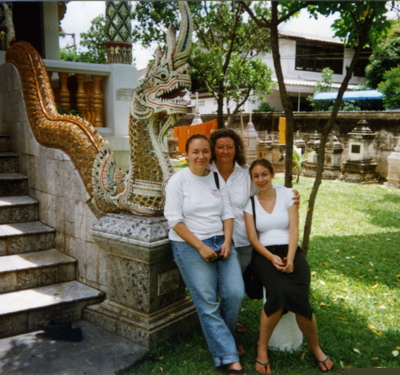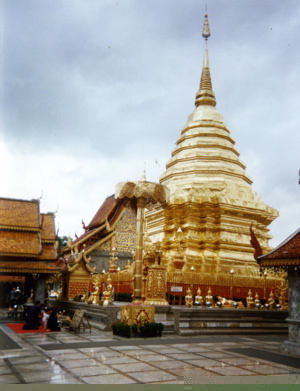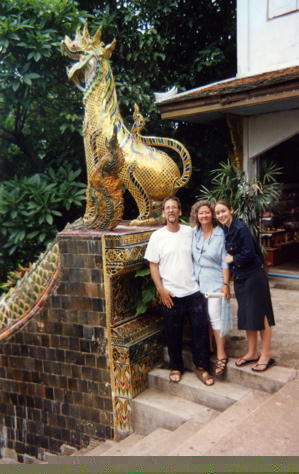Chapter 5: Thursday: Wats & Nagas, i.e. Temples & Serpents
The next morning:
Don: "I was thinking it might be nice to see Angkor Wat while we're here."
Laurie: "I thought it was too expensive."
Don: "I hope you girls aren't too disappointed. We won't be going to see the Golden Triangle."
Serena: "I have no desire to see the Golden Triangle. I was just going 'cause I thought you wanted to go. I'd much rather go to Cambodia - although I'd be happy here too."
Miranda: "I'd much rather go see another country, although I love Chiang Mai."
Laurie: "I'd love to go to Angkor! I've always wanted to go there."
Don: "Always?"
Laurie: "Ever since I was in college and had an Asian Art History class. They showed pictures of Angkor and I knew I wanted to go some day."
Don called Ms. Lek, as soon as possible, at 8:30 AM that morning, to inform her of our change of plans - that we were going to Angkor Wat rather than the Golden Triangle. She wasn't there and so he left a message.
We were picked up at the hotel at 9AM by our guide, who introduced himself as Yo. He mentioned that he was in contact with Ms. Lek by cell phone and that she was already arranging for our trip to Cambodia. He said everything would be taken care of by the end of the day. (And it was.)
He then told us that he was going to show us some temples in the morning and some factories in the afternoon.
Wat Chedi Luang, trans. ‘Monastery of the Great Stupa'
The first temple he showed us was Wat Chedi Luang, trans. 'Monastery of the Great Stupa'. It was the largest in Chiang Mai. It had been damaged by an earthquake or gunfire and was being restored. It was a pyramid with four entrances. One of the entrances had been restored, while another was going to be left intact permanently as an example of the ruin, and the last two were being worked on.

There were supposed to be Buddhas at the top of each entrance inside a little temple, harmonizing the four cardinal directions. One of the Buddhas had yet to be replaced; two of the Buddhas were golden; and one was green.
In a reverent voice Yo said: "That is a replica of the Emerald Buddha, our national treasure. The king commissioned it in 1995 to mark the 600th anniversary of the temple and the 700th anniversary of our city."
Don: "Where is the original?"
Yo: "In Bangkok in the Grand Palace. But it used to be here."
Don: "They're made of emerald?"
Yo: "No. They're made of jade."
Don: "The temple is very big."
Yo: "The spire of the stupa was so tall that it could be seen from the mountain top temple that we're going to see next."
Naga. the serpent
While the overall temple was very tall and the Buddhas were magnificent, the striking element for me was that the entrances to its four sides were each guarded by two serpent like figures - one on each side of the staircase.
Don: "What are those?"
Yo: "Those are serpents. They are guarding the Buddha."
Don: "Naga?"
Yo: "Yes. How did you know?"
Don: "A little reading. But why is the Naga serpent here?"
Yo: "Naga submitted to the Buddha. But the Buddha couldn't take her because she was an animal. However he honored Naga by allowing her to guard his temples. According to myth, the Cambodians are descended from the union of Naga with a Indian prince."
Don: "Your myths?"
Yo: "No. Their myths. But we borrowed a lot from them."
Don: "Such as?"
Yo: "Architectural styles and belief system, especially near Bangkok. It happened during the time of the Khmers."
We saw a lot of Naga serpents guarding the Buddhist temples. In fact nearly every temple seemed to have a Naga serpent guarding the inner sanctum. The iconography of the Naga serpent seemed to be this. The main body of the serpent would be the balustrade of the walkway or staircase. The head would end with the railing with his mouth open. From inside the mouth multiple Naga serpents would emerge - all with ferocious visage posed and ready to strike. There were always an odd amount of serpent heads coming out of the mouth, either 1, 3, 5, 7, or 9 Naga heads emerging from the mouth of the main Naga. Many times these Naga heads were inlaid with mirrors and colored ceramics. They are very threatening, magnificent and proud. Appearing ready to attack, if there is any false move or even any false intentions.

Contrast between Biblical Serpent and Naga
Naga, the Buddhist serpent is quite different than the Western serpent, who tempts Eve to eat the apple of knowledge in[ the Garden of Paradise. Then Eve tempts Adam. Because of their disobedience God throws Adam and Eve out of the Garden of Eden. Adam must become a farmer and Eve is cursed with her monthly periods, the snake is cursed by being despised among men. Thus the serpent is a pivotal figure in the evolution of human consciousness, at least Biblically speaking.
Let us dig a little deeper. In this story the serpent symbolizes the ancient fertility culture centered upon the female, where he represented wisdom. This is why he was tempting Eve with wisdom. However the male priestly class of the sky gods want to reserve knowledge and power for themselves. Therefore Eve and the serpent, which represent the prior fertility cults of the goddess, are vilified in the early Hebrew mythology. The serpent is, of course, of the earth as is the Goddess. They are viewed as in opposition to the sky god represented by Jehovah god of the Jews, who regularly speaks to the prophets in 'high' places.
Note the difference in the Buddhist mythology. Instead of vilifying the female serpent, Naga, she is used to guard the doorway of his temples. Naga submits to the Buddha and is assimilated rather than rejected. The Cambodian myth features an actual fusion of old and new. An Indian prince mates with the Naga serpent to create the Cambodians. India and Naga mated to form Cambodia. The beliefs of India merged with the beliefs of the earlier earth worship of the Cambodians to yield the Khmer civilization. We will see more of this when we examine the roots of Cambodia.
This is a key difference between the religions based upon the Bible and the religions of Southeast Asia of which Buddhism is dominant. The Bible rejects the serpent, calling him evil, while the Buddhist accepts the serpent as guardian of the temple. The Biblical mythology is rooted in intolerance, while the Buddhism of Southeast Asia, at least, is rooted in tolerance and assimilation. This tolerance was manifested frequently and in many different ways throughout our stay.
Thai Buddhism seems to be inclusive, rather than exclusive life our Biblical culture of the West. As an example: In Santa Barbara, California, where we come from, there are about a hundred different churches in our city of about 100,000 people. Most of these churches are based upon the same book, the Bible. And yet each church is separate from the other churches, with entirely different interpretations of the Bible. An American is not a Baptist and a Catholic and a Jew. He is a Baptist or a Catholic or Jew. Either-or. Not Both-And. Exclusive not inclusive. Contrast this with Thailand, a country of 61 million people, where 95% of its people practice Theravada Buddhism. And there are no competing sects. There is not an Eastern Orthodox Theravada Buddhism, or a Reform Theravada Buddhism, or a Traditional Theravada Buddhism, or a Modern Theravada, there is just Theravada Buddhism. They have been so inclusive that everyone has joined up.
Another feature of the Thai temples was that there were precious artifacts everywhere - all left unguarded - such as golden Buddhas with gem encrusted necklaces. These would be heavily guarded in most other countries. In Thailand, perhaps because it is so Buddhist, it would be considered a sacrilege to steal these beautiful artifacts. It wasn't until modern times that one could even take an image of the Buddha out the country. It was felt that each of the images had a little of the Buddha in him and must remain in Thailand.
Wat Phra That, the Mountain Temple
From this temple inside the moat and the city walls, Yo with his driver took us up to see the mountain temple, called Wat Phra That, on the peak of Doi Suthep, the tallest local mountain at a little over 5000 feet. Legend has it that the first Thai ruler, King Mengrai, looked up at this mountain which rises majestically over the plain of Chiang Mai and decided he wanted to build a city at its base and a temple on the mountain peak. While the city was built during his reign, it took another 100 years for the temple to be completed.
According to Yo, King Keu Naone wanted to build a temple. To decide where to build the temple, he performed an ancient ceremony designed to find powerful spots. A container with a relic of the Buddha inside, presumably some of his ashes, was placed on top of a white elephant. Then the elephant was set free. The elephant, according to legend walked to the top of Doi Suthep and then died. Because of this the King knew this spot must be powerful and so built his temple here. This was in 1383.
The temple is guarded by the Naga serpent of course. This time the Naga serpent is the undulating hand rail that takes one up 300 steps to the temple, all covered in gold leaf.

At the mountain top there is the ever-present stupa as well as the temple. The stupa always contains holy relics and is topped with a golden spire.

And of course more of the omnipresent Nagas.

All Thai youth must spend time in Buddhist monastery
From the platform of the temple one can see Chiang Mai with a bird's-eye view. Theoretically the temple that we had seen in Chiang Mai was so tall that you could see the spire of its stupa (chedi in Thai) from the Mountain temple. This was one of the symbolic elements that connected this mountain temple with the city. The connection is furthered by law. Every graduate of Chiang Mai university must first walk from the university, which is downtown, to the Mountain Temple, a three hour uphill walk before he or she can receive their diploma.
For centuries the Buddhists have been in charge of education in Thailand. It is only recently that the government has taken any part. All the young people, men and women, must spend 3 months in a Buddhist monastery.
Yo: "You have to shave your head and eyebrows. They take your clothes and give you the Buddhist robe. You are given a small room - about as big as a closet. You are fed in a small wooden bowl. You have to eat whatever you are given. Most of the time it is all mixed up." He states disgustedly.
When our young men enlist in the army, the Thai people join a monastery. Maybe this is why they seem to be more tolerant.
Thai Boxing, muay thai
On our second night in Chiang Mai, we were at the Night Bazaar, as usual, when my Person was wandering around and discovered an exhibition of 'free' Thai boxing. Testosterone rising, he encouraged the family to attend. ‘Free' attendance but we had to buy a drink. After a round and a half of the scheduled three round fight, we left. It was a bit violent for our tastes. While the kicking and hitting were relatively fine, the knees to the nose, turned our collective stomachs. Watching two humans attempting to hurt each other for a trophy seemed a little cruel to our collective compassionate feminine mentality.
According to the guide book, Thai boxing, Muay Thai, uses punches and kicks as decoys to get in closer for the more lethal knee and elbow strokes. (The only thing that can't be used is the head.) At the turn of the century Thai boxing matches frequently ended in death. Legislation tamed it from these lethal beginnings. However Thai boxers are still at the top of martial arts world, regularly winning open competitions in their weight division. No martial artist from any other discipline has ever won a championship match against a Thai boxer.[i] Presumably this is because their training is full contact where most aren't.
From Burmese accounts it seems that the early Thai Kings had to participate in a muay thai match to establish their prowess. In the late 1500s King Naresuan the Great, a topnotch muay thai boxer himself, made it a mandatory part of military training. In the early 1700s a king called 'the Tiger King' started offering prizes and established training camps to promote the 'sport'. It is said that he successfully participated in the contests. Most of the early kings were great warriors, not leaders from afar. Our Thai guide was proud to point this out to us. The Thai leader led his troops into battle. He did not direct them from. the hillside.
After many serious injuries and deaths, muay thai was banned in the 1920s. In the 1930s it was resurrected with the incorporation of the international Queensberry rules for Western boxing. Prior to this point the combatants many times had ground glass in the surface of their gloves to maximize damage. Further the gloves were only to protect the wrist from injury, not to minimize injuries in the contest. Before this point, as in Western boxing, there was no time limit on the fight. After this point the bouts were limited to five 3 minute rounds and the fighters were required to wear Western style gloves, designed to cushion blows and protect the participants from serious injury.
While gentle and compassionate the Thais also have a violent side, which can't be ignored. Thus some of my Person's idealizations about Thailand were s���������������������������������������������������������������������������������������������������������������������������������������������������������������������������������������������������������������������������������������������������������������������������������������������������������������������������������������������������������������������������������������������������������������������������������������������������������������������������������������������������������������������������������������������������������������������������������������������������������������������������������������������������������������������������������������������������������������������������������������������������������������������������������������������������������������������������������������������������������������������������������������������������������������������������������������������������������������������������������������������������������������������������������������������������������������������������������������������������������������������������������������������������������������������